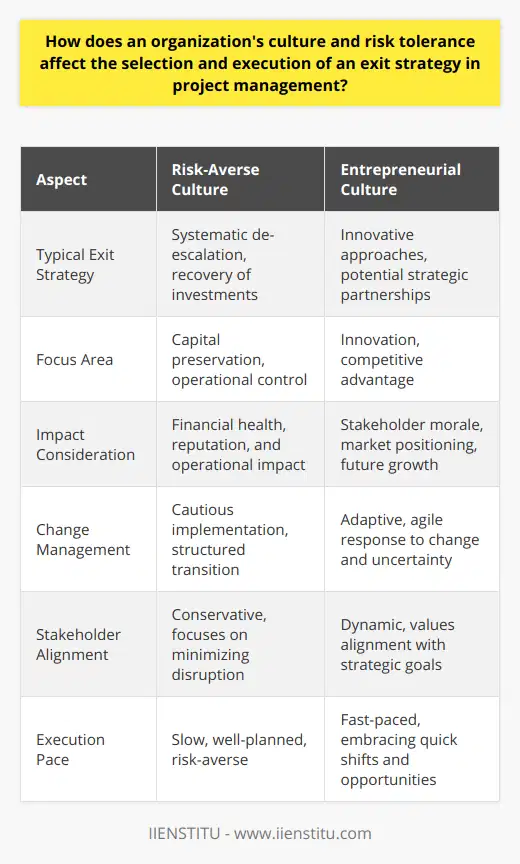
Project managers must have an exit strategy before starting a project. This ensures that the project can be completed and everyone involved knows what is expected of them. Without an exit strategy, there is a greater chance for things to go wrong and the project to flounder. Several factors need to be considered when creating an exit strategy, so let's take a closer look at what they are.
What is an exit strategy in project management, and why is it important?
An exit strategy is a carefully planned set of actions at the beginning of a project to help ensure its success and completion. It is essential because it provides structure, guidance, and accountability for everyone involved in the project. Without an effective exit strategy, there is a greater risk that things will go wrong, or the project may not be completed as expected.
There are several key factors to consider when creating an effective exit strategy for your project team. These include clearly defining goals and objectives, setting timelines and milestones, establishing clear roles and responsibilities, outlining communication protocols, identifying potential risks and challenges, and developing contingency plans.
One of the most common pitfalls with planning an exit strategy is focusing too much on how the project will be completed and not enough on how it should be ended. Therefore, it's essential to always have an exit plan in place from the beginning so that you are prepared if things go wrong or there is a need to cancel or terminate the project earlier than expected.
Suppose you find that your project needs to be canceled or terminated early. In that case, it's essential to manage this process as smoothly as possible by communicating clearly with all stakeholders, addressing any potential risks or concerns, and providing support for those who may be affected. This can help ensure a successful transition when the project has been completed.
Ultimately, an effective exit strategy is critical for any successful project management initiative. Planning carefully and proactively outlining your team's exit strategy from the beginning can help ensure that your project is completed successfully and on time on time, with minimal disruption or negative impacts.
How can you create an effective exit strategy for your project team?
There are several vital steps that you can take to create an effective exit strategy for your project team. These include clearly defining project goals and objectives, setting timelines and milestones, establishing clear roles and responsibilities, outlining communication protocols, identifying potential risks and challenges, and developing contingency plans.
To start, it is essential to define the overall goals and objectives of the project clearly. This should include all aspects of the initiative, such as deliverables, resources required, budget allocation, timeline expectations, etc. Once this has been established, you can set realistic timelines and milestones that will help keep your project on track.
In addition to clear goal-setting and timeline management, it is also essential to establish clear roles and responsibilities within your team. This should include a clear understanding of who is responsible for what aspects of the project and what support and resources are available to help ensure its success.
Communication is another critical factor in an effective exit strategy, and it's important to develop protocols that will facilitate regular and open communication throughout the project lifecycle. This can involve setting up regular status meetings or reporting requirements, defining escalation procedures for addressing issues or concerns, and creating information repositories or other tools to share relevant project information among team members.
Finally, it is also critical to identify potential risks and challenges early on and develop contingency plans that can be implemented if needed. By thinking through possible challenges or obstacles ahead of time, you can better prepare your team to respond quickly and effectively if anything goes wrong.
Overall, there are many factors to consider when creating an effective exit strategy for your project team. However, by focusing on goal-setting, communication, risk management, and contingency planning from the beginning, you can help ensure that your project is completed successfully and on time, with minimal disruption or negative impacts.
What are some common pitfalls to avoid when planning for an exit strategy?
There are several common pitfalls to avoid when planning for an exit strategy, including failing to set realistic timelines and goals, underestimating the challenges or risks involved, overlooking the importance of communication and collaboration, and needing more resources or support.
One common pitfall is setting realistic timelines or goals that are difficult to achieve. This can cause your team to become discouraged or frustrated if they feel they are constantly falling behind, leading to decreased motivation and lower productivity levels.
Another critical factor is underestimating the challenges and risks associated with a project. This can make it difficult to plan effectively and respond quickly to potential issues. It can also increase the chance of negative impacts on other aspects of the project, such as cost overruns or quality issues.
In addition to setting unrealistic timelines and failing to anticipate challenges and risks, your team must also focus on effective communication. This includes sharing information openly and regularly, ensuring all team members feel heard and supported, and establishing clear escalation procedures for addressing conflicts or concerns.
Finally, having sufficient resources is critical when planning an exit strategy. This includes having enough time, budget, and staff allocated to the project to complete all necessary tasks successfully. With adequate resources in place, managing your timeline effectively and responding quickly if unexpected obstacles arise can be more accessible.
Overall, many factors can impact the success of your exit strategy, and it is essential to be aware of these common pitfalls so that you can avoid them as much as possible. By focusing on realistic timelines and goals, anticipating challenges and risks, prioritizing communication, and allocating adequate resources, you can help ensure the success of your project from beginning to end.
What should you do if things go wrong and the project needs to be canceled or terminated early?
If a project needs to be canceled or terminated early, it is essential to take proactive steps to minimize the impact on all stakeholders. The first step is to assess the situation and identify any potential issues that may have contributed to the need for cancellation. This could include budget constraints, missed deadlines, disappointing performance results, or other unforeseen circumstances. Depending on the nature of the issue, it may also be necessary to develop a contingency plan that outlines new approaches for wrapping up work on the project.
Once these steps have been completed, it is essential to communicate this change clearly across all teams involved in the project. In addition, it is necessary to explain why the decision was made and what will be done moving forward to reduce any confusion or distrust among team members. Finally, it is crucial to document all decisions and outcomes so they can be referred back to at a later date if needed. With proper planning and communication, early cancellation or termination of a project can hopefully still deliver positive results for everyone involved.
How can you ensure a smooth and successful transition when the project is completed?
One key factor to ensuring a smooth, successful transition when a project is completed is to develop strong relationships and effective communication with all stakeholders. This includes regularly sharing information on progress and setbacks, listening to any concerns or suggestions from team members, and responding quickly to any issues that arise.
Additionally, periodically assess the project's overall health as it progresses to identify potential areas for improvement or corrective actions.
Another important consideration has sufficient resources in place throughout the entire project timeline. This means having skilled and experienced staff, adequate funding allocated for various aspects of the work, and clearly defined objectives that everyone can work towards together. Focusing on these critical factors can help ensure a smooth and successful transition when the project is completed.
Ultimately, it is up to you to take responsibility for guiding the project from start to finish, and it will require ongoing diligence, communication, and collaboration to succeed.
Overall, creating and implementing a successful exit strategy is essential for any project's success. To do this effectively, it is necessary to take proactive steps to anticipate challenges and risks, allocate adequate resources, prioritize effective communication, and carefully manage all aspects of the work from beginning to end.
Focusing on these critical factors can help ensure a smooth and successful transition when your project has been completed. In addition, whether managing an internal initiative or working with external partners on a collaborative effort, it is crucial to remain diligent and committed throughout the process to achieve your goals with maximum efficiency and effectiveness.
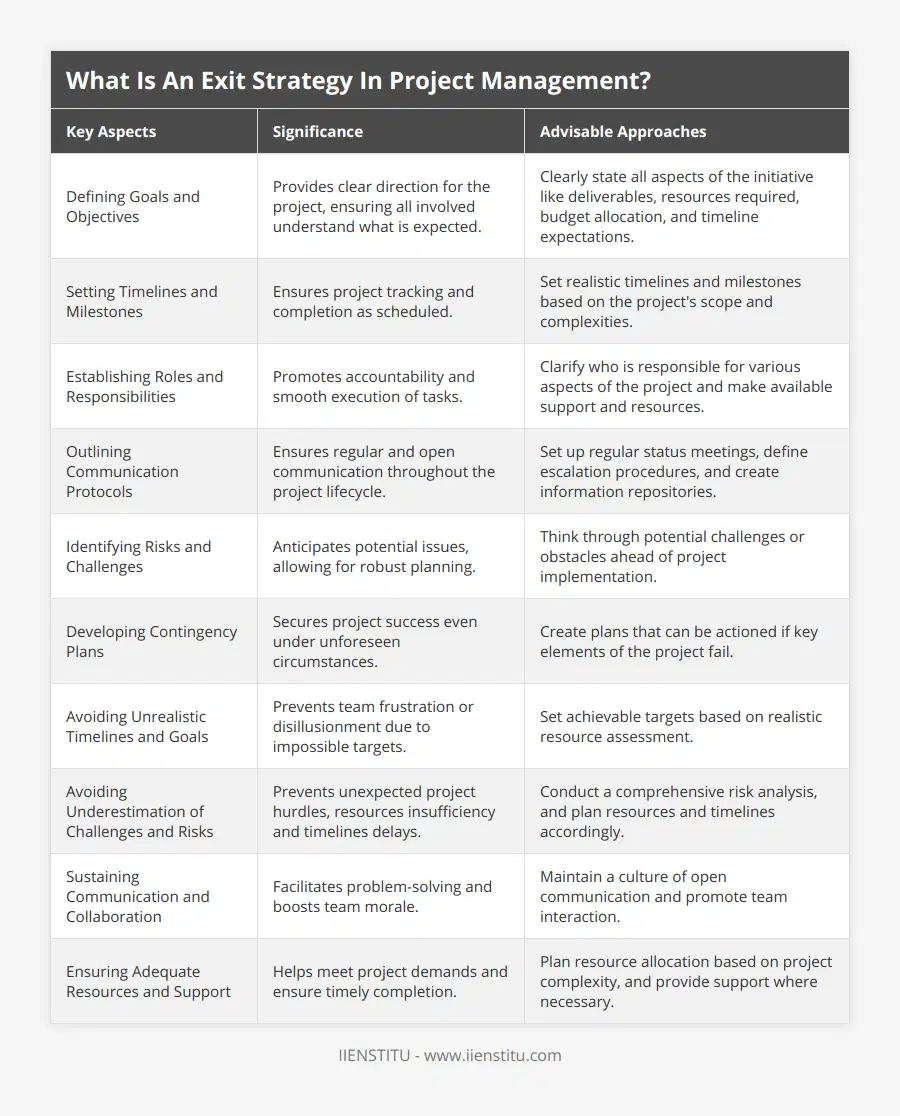
Frequently Asked Questions
What is an exit strategy in project management?
An exit strategy is a plan in project management that defines how a project will be brought to a close. The exit strategy should include details on how the project will be formally closed, how final reports will be generated, and who will be responsible for each step. Having a clear plan for completing a project is essential so that everyone involved knows what's happening and expectations are set.

What are some of the benefits of having an exit strategy?
An exit strategy is essential for several reasons. First, it provides peace of mind in knowing that you have a plan if things don't work out with your business. Second, it allows you to get the most value possible for your business when you decide to sell. Third, it helps ensure that your employees are taken care of if and when you leave the company. Finally, it gives you a roadmap to follow as you grow your business. By having an exit strategy in place, you can be sure that you're making the most of the time and effort spent building your company.
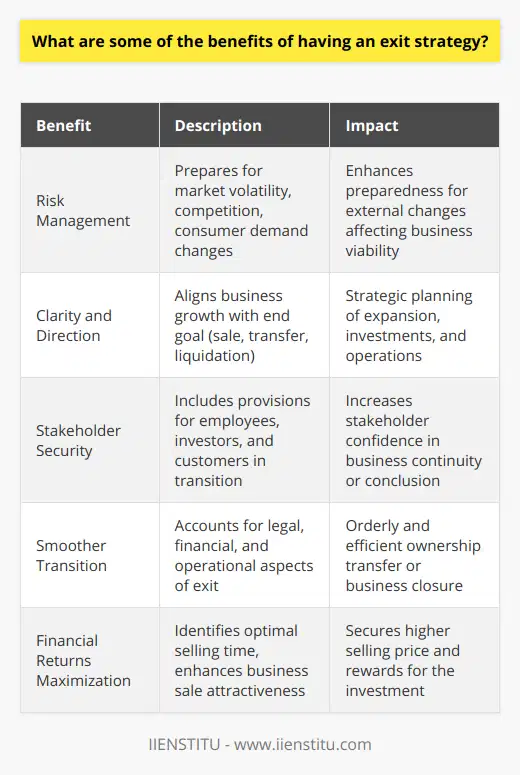
What are some of the challenges of developing an exit strategy?
There are a few critical challenges associated with developing an exit strategy:
1. Determining the right time to exit
2. Figuring out the best way to monetize the business
3. Protecting your interests during negotiations
4. Making sure the transition is smooth for employees and customers

How can you ensure that your exit strategy is successful?
There are a few key things to keep in mind when planning your exit strategy:
Make sure you have a solid plan in place. This includes having clear goals, a well-defined timeline, and a detailed budget.
Choose the right time to leave. Ensure the market is favorable and that your company is financially in a good position.
Have a backup plan if things don't go as planned. This could include having another job lined up or having enough savings to support yourself for some time.
Leave on good terms with your colleagues and customers. Grudges can hold you back from achieving success after leaving your company
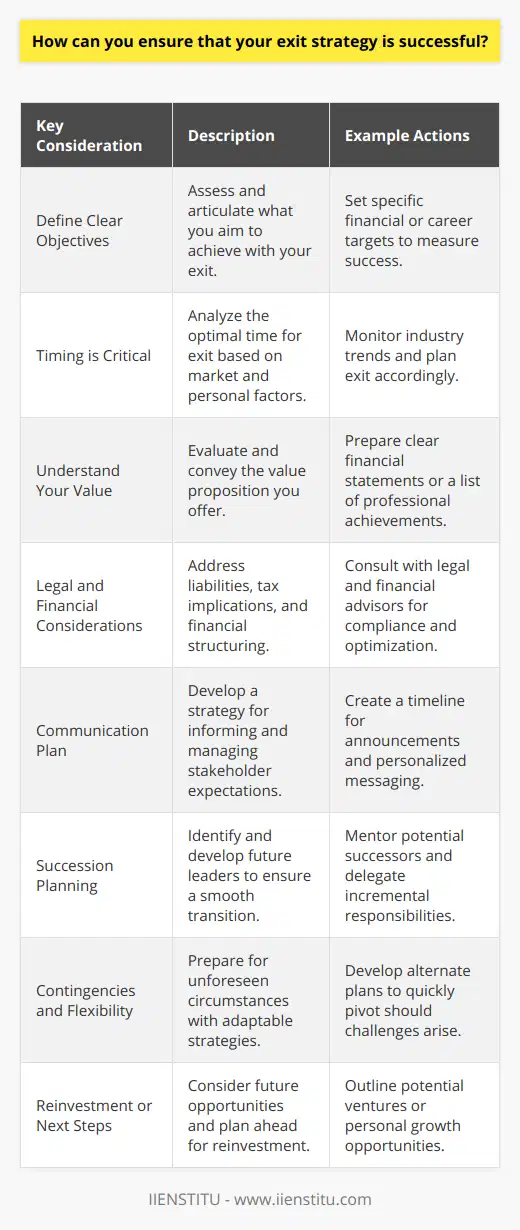
Do you need to consider other factors when planning an exit strategy?
You'll need to consider a few other factors when planning your exit strategy. One of the most important is your company's financial stability. If your company needs to do better, finding a buyer or partner interested in acquiring it will be more challenging. You'll also need to consider your employees and how the sale or closure of your company will impact them.
Another thing to keep in mind is intellectual property (IP). If you have any valuable IP you plan to take with you when you leave, make sure you have written agreements with your current or former employer outlining who retains ownership of the IP. Finally, always consult with an attorney before making any significant decisions regarding your business.
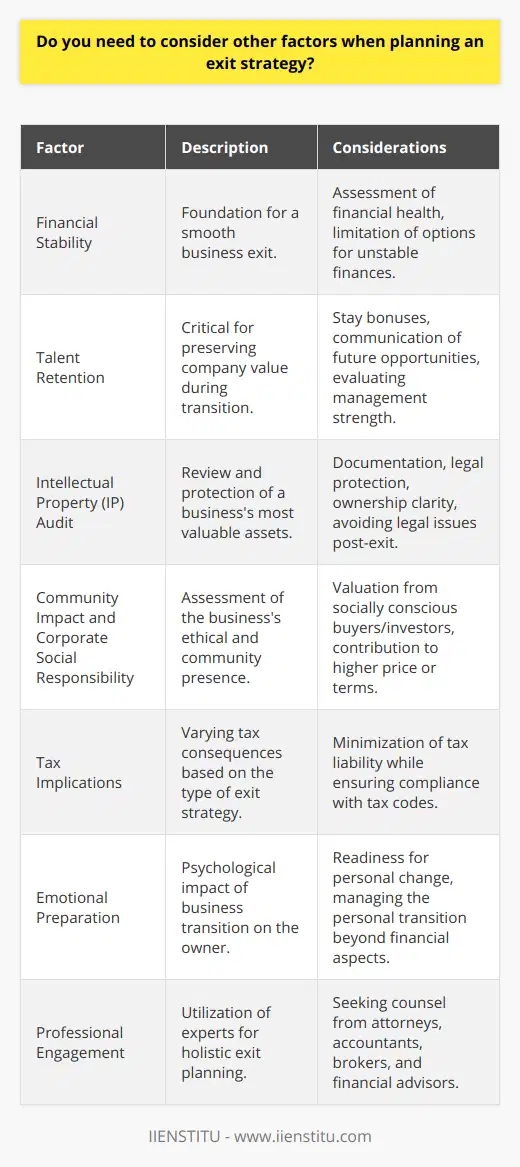
What are some common exit strategies in project management?
Some common exit strategies in project management are as follows:
Finish the project on time and within budget. Of course, this is the ideal scenario, and it's what every project manager strives for.
Cancelling the project. Again, this is not a desirable outcome, but it does happen from time to time.
Delaying the project. Sometimes projects need to be delayed due to unforeseen circumstances.
Restructuring the project. This can involve splitting or combining projects, adding or deleting tasks, etc.
Ending the project prematurely. This is always a last resort and should only be used when no other option is available.
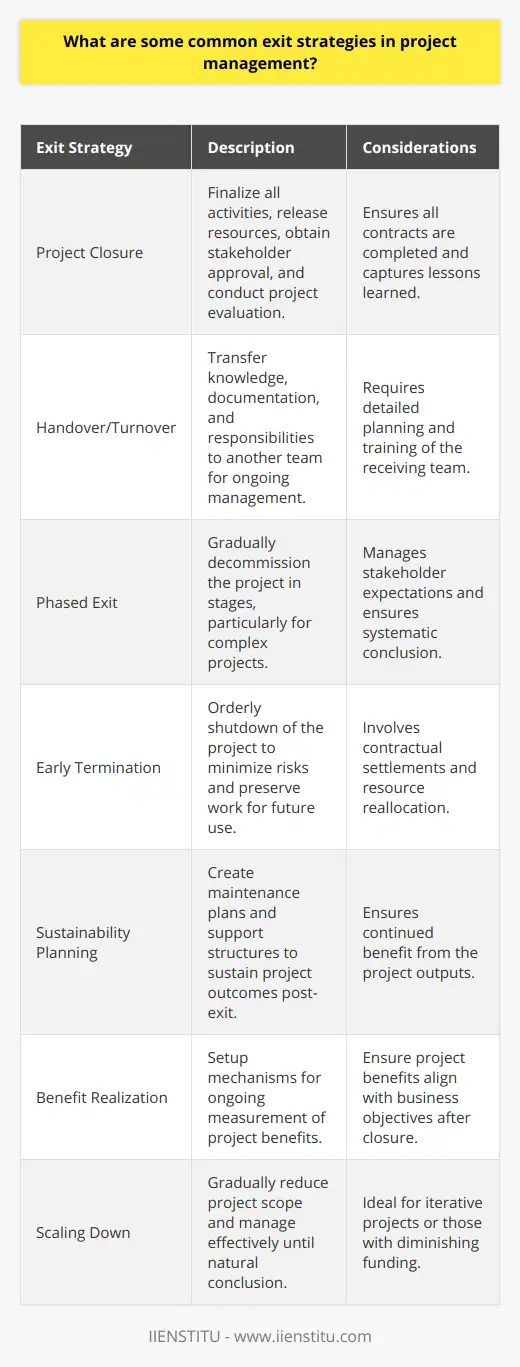
What is the importance of an exit strategy in a project's lifecycle?
Exit Strategy Significance
An exit strategy is a crucial component of a project's lifecycle, which aims to ensure a well-orchestrated completion or termination of a project. Projects are temporary, and therefore, having a solid exit or transition plan in place, whether it's for completion or early termination, is vital in safeguarding a project's overall success.
Effective Resource Allocation
One of the primary reasons for having an exit strategy is that it promotes effective resource allocation. Starting a project without an exit plan increases uncertainty and leads to a wastage of valuable resources. Exit strategies enable project managers to allocate resources, including team members, time, and budget, in a more informed manner, ensuring that resources are allocated only to those aspects of the project that are critical to its success.
Risk Mitigation
Another importance of an exit strategy in a project's lifecycle is risk mitigation. Project managers need to anticipate the likelihood of potential risks and devise strategies to address them in advance. A well-planned exit strategy enables them to have contingency plans in place that minimize the impact of unforeseen events, such as a loss of funding, changes in government regulations or environmental conditions, sudden market shifts, and other emergencies.
Smooth Transition
Moreover, a well-defined exit strategy ensures a smooth transition of a project to its intended beneficiaries or to another organization responsible for ongoing operations. This entails defining and documenting processes and procedures, ensuring proper knowledge transfer, and providing necessary training and support. Consequently, project closure becomes a systematic and organized change that does not leave stakeholders in disarray.
Determining Success Metrics
Lastly, having an exit strategy in place aids in measuring project success. Through the strategy, success metrics, such as key performance indicators (KPIs), are explicitly defined. By monitoring and evaluating these metrics, project managers can continually assess whether a project is progressing towards its objectives or if it needs adjustments.
In conclusion, an exit strategy is an indispensable element of a project's lifecycle. It plays a crucial role in effective resource allocation, risk mitigation, smooth transition, and measuring project success. A well-defined exit strategy helps ensure that a project is delivered to its beneficiaries in a timely and efficient manner, making it a vital aspect of project management.
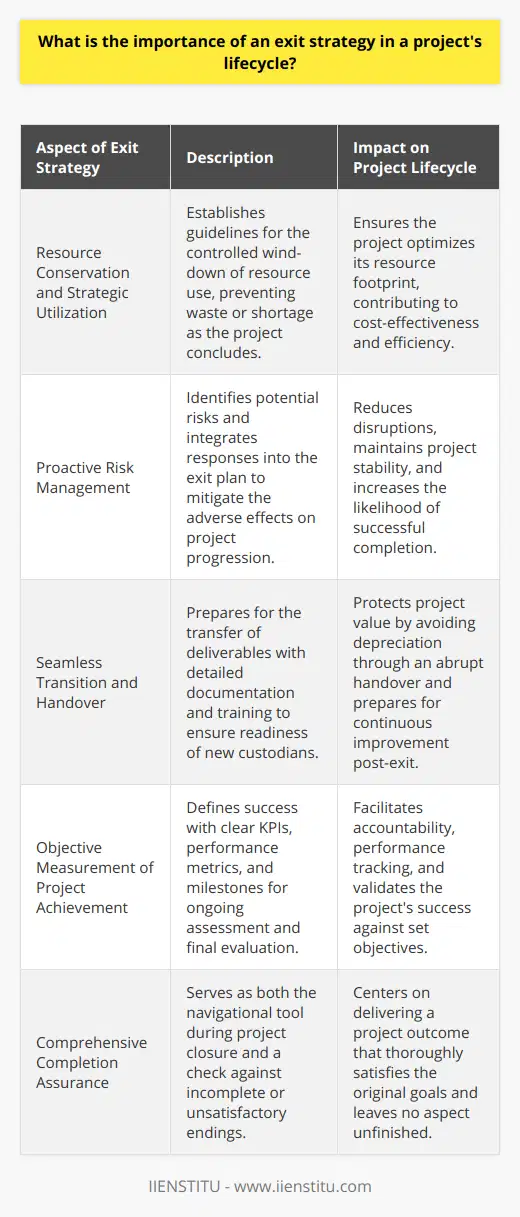
How do external factors influence the choice of an exit strategy?
External Factors Affecting Exit Strategy Choices
Macro-Economic Context
The macro-economic environment, which includes factors such as inflation, interest rates, and overall economic growth, have a significant impact on the choice of an exit strategy for a blog post. When the economy is flourishing, the demand for blog content may increase, leading to higher revenues and thus, making it attractive for investors to hold on to their blog assets. Conversely, during economic downturns, blogs may be more challenging to monetize, making it necessary to consider exit strategies such as selling or merging.
Competitive Landscape
In addition to the macro-economic factors, the competitive landscape of the blog market plays a crucial role in shaping the choice of an exit strategy. A blog post that operates in a highly competitive segment, where it struggles to differentiate its content, is a suitable candidate for a merger or acquisition by a stronger player, enabling the blog post to benefit from the synergies brought by the deal. On the other hand, a blog with a dominant market position and unique content has higher chances of attracting potential buyers, making an outright sale a more suitable exit strategy.
Regulatory Environment
The regulatory environment directly impacts the choice of an exit strategy, as it may impose restrictions or create opportunities for blog posts. For instance, stringent regulations on online content and advertising can lead to a decline in blog revenues and may necessitate the need to consider a divestment or a strategic partnership. Additionally, changes in tax policies may impact the valuation of blog posts, influencing the decision to sell, merge, or go public.
Technological Developments
Rapid technological developments and changing consumer preferences can significantly influence the choice of an exit strategy for a blog post. Adoption of new technologies, such as artificial intelligence or virtual reality, may enhance the value of blogs focused on these topics, leading to higher acquisition offers or opportunities for initial public offerings. Conversely, blogs unable to adopt new technologies might lose their competitive edge, leading to a consideration of selling, merging, or even shutting down the blog.
In conclusion, a range of external factors, including the macro-economic context, competitive landscape, regulatory environment, and technology advancements, play vital roles in influencing the choice of an exit strategy for blog posts. It is crucial to evaluate and monitor these factors to make informed decisions about the most suitable exit strategy.
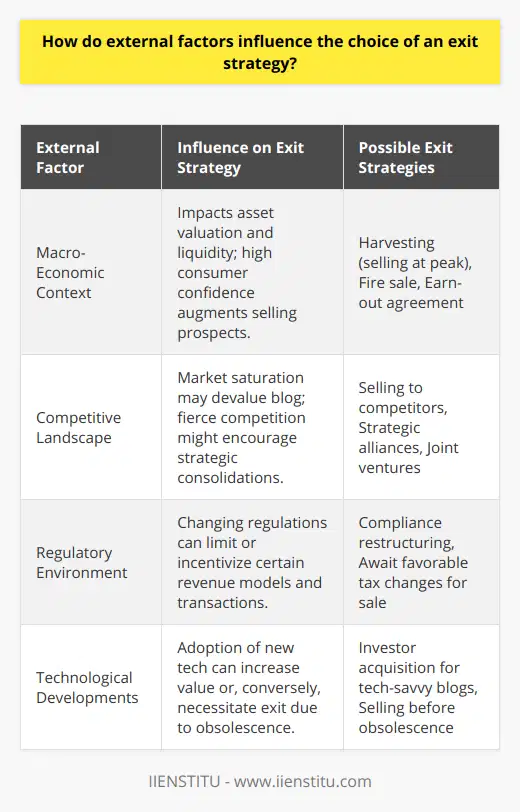
How do project stakeholders impact the development and execution of an exit strategy?
Stakeholder Influence on Exit Strategy Development
Project stakeholders are fundamental in shaping an exit strategy, as their needs, interests, and perspectives collectively influence the development and execution of such plans. The first step in understanding this impact is to identify and categorize project stakeholders. These typically include internal stakeholders, such as project managers and team members, and external stakeholders, like clients, partners, investors, and suppliers.
Prioritization of Stakeholder Perspectives
To evaluate the impact of stakeholders on exit strategy development, prioritizing their perspectives is essential. Stakeholders with significant investments or essential project roles will likely have a greater effect on the decision-making process. For example, project managers can push for a systematic and transparent approach, focusing on achieving project objectives before the exit. In contrast, investors may emphasize on financial gains, favoring a well-timed exit strategy to optimize returns.
Negotiation and Consensus Building
Another factor in stakeholder-driven exit strategy development is the necessity for negotiation and consensus building. High levels of stakeholder engagement and communication are imperative to ensure a shared understanding of the strategic goals and objectives. This collaboration will facilitate the development of an effective exit strategy that is mutually acceptable and beneficial for all involved parties.
Adoption of Recommendations
Stakeholders with industry knowledge or technical expertise can provide invaluable insight into the most effective ways to execute an exit strategy. Their recommendations and feedback can contribute to shaping a data-driven, well-structured exit plan, thereby improving the likelihood of the project's success. Ignoring expert input could result in a poorly developed exit strategy and jeopardize the long-term viability of the project.
Monitoring and Evaluation
Project stakeholders can also impact the execution of an exit strategy through their involvement in monitoring and evaluation processes. Regular assessments allow stakeholders to determine the progress of the project and make adjustments to the exit strategy as needed. Monitoring ensures that the exit strategy aligns with the stakeholders' objectives and that all parties continue to collaborate effectively toward a successful conclusion.
In conclusion, project stakeholders play a pivotal role in the development and execution of exit strategies. By identifying, prioritizing, negotiating, and incorporating stakeholder perspectives, a collaborative and effective exit strategy can be developed that meets the needs and expectations of all involved parties. Regular monitoring, evaluation, and adaptation also contribute to ensuring the success of the project and the exit process.

What is an exit strategy in a project, and when should it be implemented?
Defining Exit Strategy
An exit strategy in a project refers to a preplanned approach designed to withdraw from an ongoing project or to terminate a failing project. It serves as a contingency plan to ensure minimal losses or adverse consequences in case the project fails to deliver its intended objectives.
Conditions for Implementation
An exit strategy should be implemented when a project experiences one or multiple unfavorable circumstances that cannot be resolved by mitigation or modification. These conditions include, but are not limited to, disregarded team alignment, insufficient financial resources, unattainable deliverables, overstretched timelines, and unidentified stakeholders.
Early Recognition and Preparedness
Implementation of an exit strategy calls for early recognition of potential project failure indicators. Project managers and team members should thoroughly monitor and evaluate project progress to identify possible pitfalls that might necessitate an exit strategy. Conducting project risk assessments and reviews at regular intervals can facilitate the early detection of warning signals and prompt decision-making.
Elements of an Effective Exit Strategy
A well-formulated exit strategy comprises several components designed to minimize disruptions, losses, and reputational damage during project termination. Key elements include:
Risk Management: Assessing project risks and establishing mitigation plans helps determine the conditions under which an exit strategy might be required.
Stakeholder Communication: Transparent communication of project status and potential challenges with stakeholders is essential. This ensures that all parties are equipped with the necessary information to make informed decisions.
Financial Optimization: Identifying areas of cost-saving or reallocation of resources can significantly decrease financial losses in the event of a project exit.
Legal Compliance: Ensuring adherence to contractual obligations and regulatory requirements is crucial to avoid potential litigations and penalties.
Knowledge Transfer: Documenting project learnings and transferring knowledge to relevant personnel fosters continuous improvement and better preparedness for future projects.
In conclusion, an exit strategy is an indispensable aspect of project management, crucial for ensuring appropriate planning and preparedness for unfavorable project outcomes. Early recognition of potential risks, combined with effective exit strategy elements, will minimize adverse consequences for the organization and stakeholders.
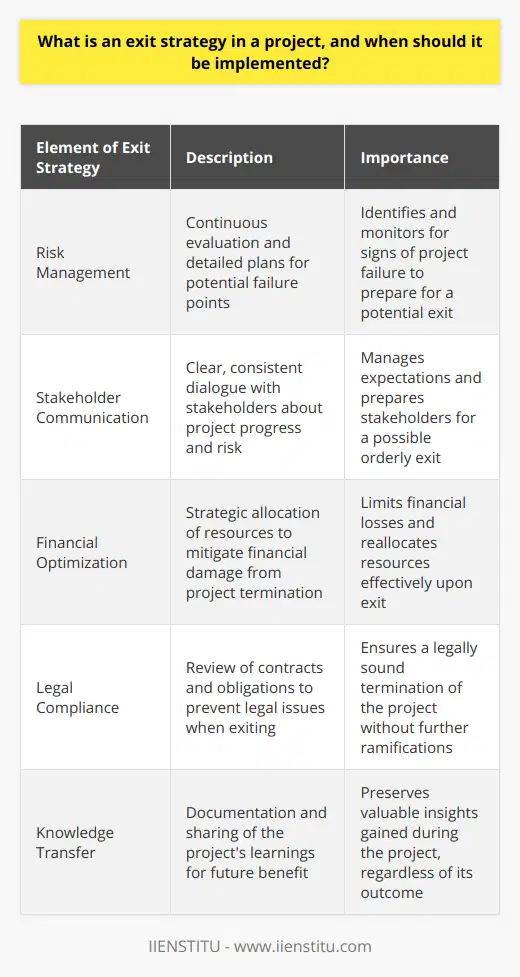
How can an exit strategy be tailored to suit a project's specific requirements and objectives?
Understanding the Project's Objectives
To tailor an exit strategy for a project, it is crucial to have a clear understanding of the project's specific requirements and objectives. This includes identifying its primary goals, its scope, and its intended benefits. Proper delineation of these specifications helps in establishing a suitable framework for the exit strategy.
Assessing Project Risks
Prudent assessment of potential risks is essential in designing an exit strategy tailored to the project's unique circumstances. By identifying and evaluating possible pitfalls and challenges, such as technical complexities or market uncertainties, it is possible to develop an actionable plan that accommodates these contingencies, effectively mitigating risks.
Defining Success Criteria
A customized exit strategy must clearly outline the criteria for determining if a project has been successful. This involves establishing specific, measurable, achievable, relevant, and time-bound (SMART) objectives that serve as a guideline for evaluating project results. Establishing success criteria ensures that one can make informed decisions regarding project continuation or termination.
Consistent Monitoring and Evaluation
Continuous monitoring and evaluation of the project's progress amidst dynamic business environments is essential for designing an adaptive exit strategy. By comparing actual results with predefined success criteria, deviations can be promptly identified, and corresponding corrective actions can be taken. Consistent monitoring ensures that decisions made align with the project's intended objectives and stakeholder expectations.
Flexibility and Adaptability
Considering the fluid nature of projects, it is imperative that exit strategies exhibit flexibility and adaptability. Incorporating contingency plans and alternative approaches into the strategy fosters an environment that allows for pivoting and adjusting to unforeseen developments or changing project requirements.
Stakeholder Engagement
Engaging relevant stakeholders throughout the project lifecycle is vital in crafting an exit strategy tailored to the project's unique circumstances. Open communication channels with stakeholders, like sponsors, clients, and team members, enable a better understanding of their needs and expectations, thereby allowing the development of an exit strategy that serves all parties adequately.
In conclusion, a well-tailored exit strategy requires a thorough understanding of a project's requirements and objectives, thoughtful risk assessment, the definition of success criteria, consistent monitoring and evaluation, flexibility, and stakeholder engagement. By integrating these elements, one can develop an exit strategy that effectively meets the project's unique needs, mitigating potential pitfalls and ensuring a successful outcome.
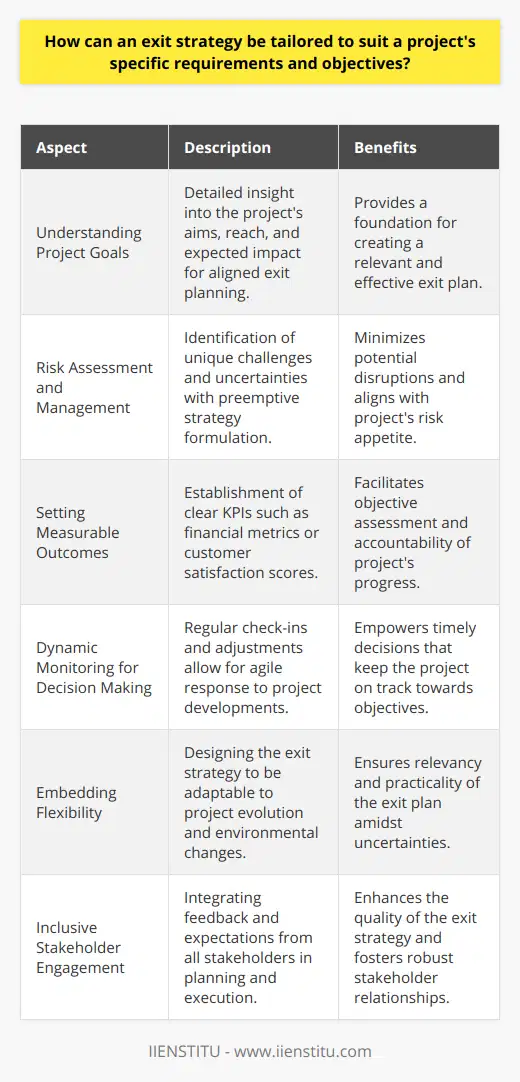
How does an organization's culture and risk tolerance affect the selection and execution of an exit strategy in project management?
Organizational Culture and Exit Strategy
An organization's culture greatly influences its tolerance for risk and hence, the selection and execution of an exit strategy in project management. When an organization has a culture that fosters innovation and risk-taking, it might favor exit strategies that capitalize on opportunities to maximize value, such as through strategic acquisitions or partnerships.
Risk Tolerance and Exit Strategy Selection
Conversely, organizations with a more conservative corporate culture may lean towards exit strategies that minimize risk exposure and ensure a predictable return on investment, such as gradual divestiture or liquidation. Therefore, understanding the organization's risk tolerance, which is deeply rooted in its culture, is essential for identifying an appropriate exit strategy.
Effective Execution of the Selected Strategy
The successful execution of an exit strategy is also dependent on the support and commitment from the organization's stakeholders. For instance, a high-risk, high-reward exit strategy may face resistance from stakeholders who prioritize stability and predictability. Similarly, shareholders, employees, and other stakeholders who support the organization's risk-taking culture may perceive a cautious exit strategy as too conservative and unaligned with the organization's values.
Facilitating Change through Organizational Culture
Organizational culture affects not only the selection and execution of an exit strategy but also the overarching approach to change management. When an exit strategy involves a significant organizational change, such as a merger or acquisition, it is the shared values, beliefs, and norms within the organization that tend to determine how smoothly the change is executed. Strong internal communication, supportive leadership, and employee involvement are vital elements in facilitating change and can be achieved more easily in organizations with a collaborative and adaptive culture.
In conclusion, an organization's culture and risk tolerance have a profound impact on the selection and execution of an exit strategy in project management. Organizations with a flexible, risk-taking culture may choose more ambitious exit strategies and are better equipped to manage the associated changes, while conservative organizations are likely to opt for safer approaches. Thus, it is important for project managers and decision-makers to consider the organization's culture and risk tolerance when determining the most suitable exit strategy.
